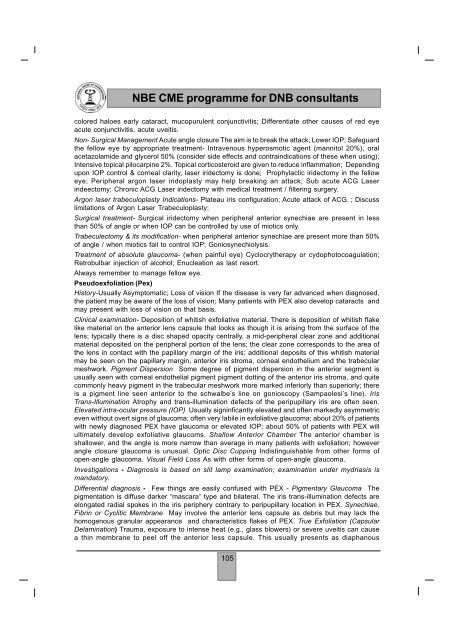NBE CME programme for DNB consultants - National Board Of ...
NBE CME programme for DNB consultants - National Board Of ...
NBE CME programme for DNB consultants - National Board Of ...
Create successful ePaper yourself
Turn your PDF publications into a flip-book with our unique Google optimized e-Paper software.
<strong>NBE</strong> <strong>CME</strong> <strong>programme</strong> <strong>for</strong> <strong>DNB</strong> <strong>consultants</strong>colored haloes early cataract, mucopurulent conjunctivitis; Differentiate other causes of red eyeacute conjunctivitis, acute uveitis.Non- Surgical Management Acute angle closure The aim is to break the attack; Lower IOP; Safeguardthe fellow eye by appropriate treatment- Intravenous hyperosmotic agent (mannitol 20%), oralacetazolamide and glycerol 50% (consider side effects and contraindications of these when using);Intensive topical pilocarpine 2%. Topical corticosteroid are given to reduce inflammation; Dependingupon IOP control & corneal clarity, laser iridectomy is done; Prophylactic iridectomy in the felloweye; Peripheral argon laser iridoplasty may help breaking an attack; Sub acute ACG Laserirideectomy; Chronic ACG Laser iridectomy with medical treatment / filtering surgery.Argon laser trabeculoplasty Indications- Plateau iris configuration; Acute attack of ACG. ; Discusslimitations of Argon Laser Trabeculoplasty;Surgical treatment- Surgical iridectomy when peripheral anterior synechiae are present in lessthan 50% of angle or when IOP can be controlled by use of miotics only.Trabeculectomy & its modification- when peripheral anterior synechiae are present more than 50%of angle / when miotics fail to control IOP; Goniosynechiolysis.Treatment of absolute glaucoma- (when painful eye) Cyclocrytherapy or cydophotocoagulation;Retrobulbar injection of alcohol; Enucleation as last resort.Always remember to manage fellow eye.Pseudoexfoliation (Pex)History-Usually Asymptomatic; Loss of vision If the disease is very far advanced when diagnosed,the patient may be aware of the loss of vision; Many patients with PEX also develop cataracts andmay present with loss of vision on that basis.Clinical examination- Deposition of whitish exfoliative material. There is deposition of whitish flakelike material on the anterior lens capsule that looks as though it is arising from the surface of thelens; typically there is a disc shaped opacity centrally, a mid-peripheral clear zone and additionalmaterial deposited on the peripheral portion of the lens; the clear zone corresponds to the area ofthe lens in contact with the papillary margin of the iris; additional deposits of this whitish materialmay be seen on the papillary margin, anterior iris stroma, corneal endothelium and the trabecularmeshwork. Pigment Dispersion Some degree of pigment dispersion in the anterior segment isusually seen with corneal endothelial pigment pigment dotting of the anterior iris stroma, and quitecommonly heavy pigment in the trabecular meshwork more marked inferiorly than superiorly; thereis a pigment line seen anterior to the schwalbe’s line on gonioscopy (Sampaolesi’s line). IrisTrans-Illumination Atrophy and trans-illumination defects of the peripupillary iris are often seen.Elevated intra-ocular pressure (IOP) Usually signinficantly elevated and often markedly asymmetriceven without overt signs of glaucoma; often very labile in exfoliative glaucoma; about 20% of patientswith newly diagnosed PEX have glaucoma or elevated IOP; about 50% of patients with PEX willultimately develop exfoliative glaucoms. Shallow Anterior Chamber The anterior chamber isshallower, and the angle is more narrow than average in many patients with exfoliation; howeverangle closure glaucoma is unusual. Optic Disc Cupping Indistinguishable from other <strong>for</strong>ms ofopen-angle glaucoma. Visual Field Loss As with other <strong>for</strong>ms of open-angle glaucoma.Investigations - Diagnosis is based on slit lamp examination; examination under mydriasis ismandatory.Differential diagnosis - Few things are easily confused with PEX - Pigmentary Glaucoma Thepigmentation is diffuse darker “mascara” type and bilateral. The iris trans-illumination defects areelongated radial spokes in the iris periphery contrary to peripupillary location in PEX. Synechiae,Fibrin or Cyclitic Membrane May involve the anterior lens capsule as debris but may lack thehomogenous granular appearance and characteristics flakes of PEX. True Exfoliation (CapsularDelamination) Trauma, exposure to intense heat (e.g., glass blowers) or severe uveitis can causea thin membrane to peel off the anterior less capsule. This usually presents as diaphanous105
















